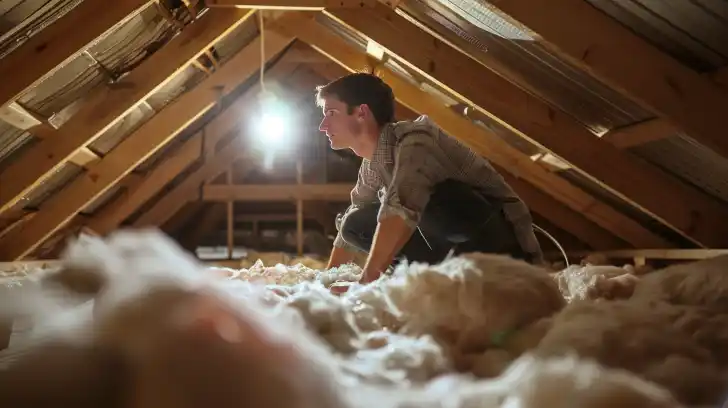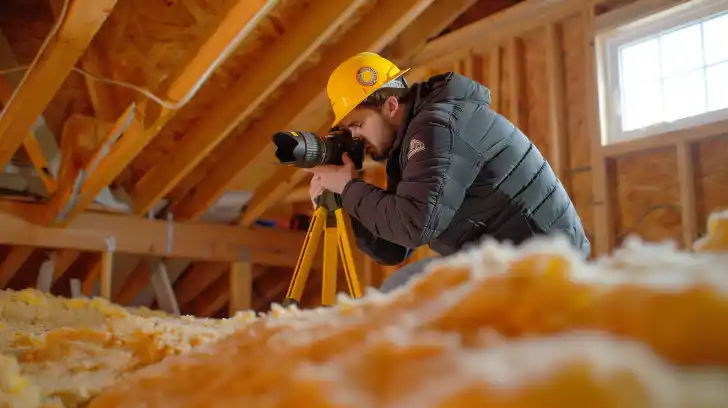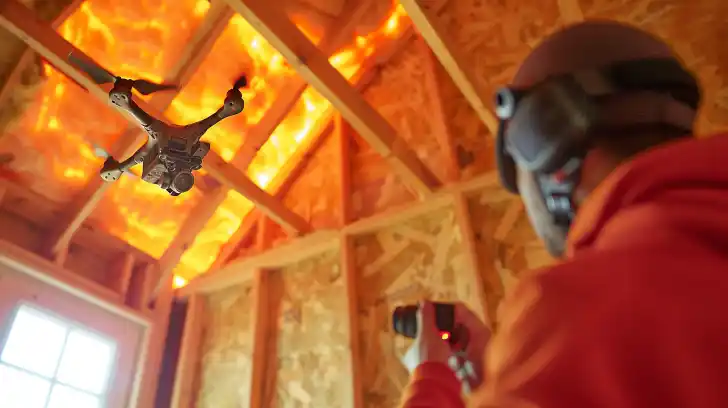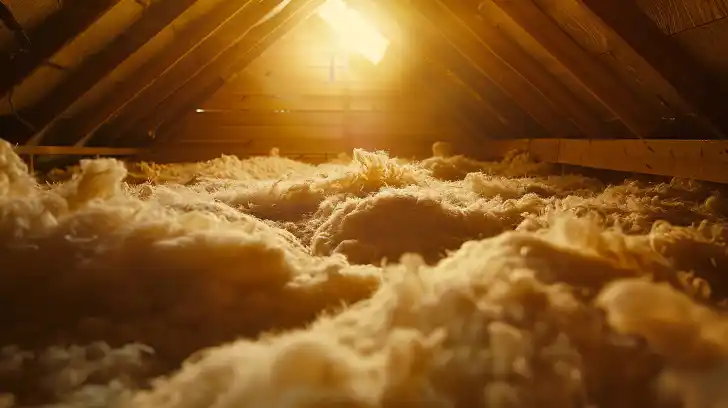Hidden Attic Fixes That Slash Energy Bills – Experts Share Insulation Tips
Published on
11 minute read

Energy bills skyrocketing? You’re not alone. Proper attic insulation can save homeowners an average of 15% on heating and cooling costs. This blog post reveals expert tips on hidden attic fixes that slash energy bills.
Read on to learn insulation secrets that keep money in your pocket.
Key Takeaways
- Proper attic insulation can reduce heating and cooling costs by an average of 15%, according to experts. Assessing current insulation levels, identifying air leaks, and sealing gaps are crucial first steps.
- Choosing the right insulation material with a high R-value, such as closed-cell foam (R-6.0 to R-7.0), fiberglass batts (R-2.9 to R-3.8), or cellulose (R-3.1 to R-3.8), can significantly improve energy efficiency and thermal resistance.
- While professionals handle insulation installations expertly, calculating the total insulation needed and estimating costs (ranging from $0.80 to $7 per square foot) are essential for successful DIY projects.
- Proper attic insulation prevents heat loss during winter, reducing strain on heating systems and potentially saving up to 45% on utility bills, according to the U.S. Environmental Protection Agency.
- Many governments and utility companies offer rebates for homeowners who install or improve insulation, offsetting upfront costs and providing long-term savings that exceed installation expenses over decades.
Evaluating Current Attic Insulation
Many homes have inadequate attic insulation. Homeowners must assess current insulation levels and identify air leaks.
Proper attic insulation is crucial for energy efficiency and reducing utility bills. Homeowners should inspect the insulation material, its thickness, and any gaps or cracks that allow air infiltration.
Addressing these issues can lead to significant energy savings.
Assessing Insulation Levels
Evaluating insulation levels is critical. Inspect the attic floor. Look for gaps or uneven coverage. Measure insulation depth using a ruler or measuring tape. Insufficient insulation allows heat transfer.
This increases energy bills.
An insulation inspection kit aids assessment. The kit contains tools like caulk, weatherstripping, and duct sealant. These materials seal air leaks. Sealing cracks and openings prevents energy loss.

Identifying Air Leaks and Sealing Gaps
Air infiltration is a major source of energy waste. It allows conditioned air to escape while letting outdoor air inside. To prevent this, identify and seal air leaks.
Inspect the attic thoroughly:
- Look for cracks, gaps, and holes around chimneys, pipes, wires, exhaust fans, and attic hatches.
- Check the top plates where walls meet the attic floor for unsealed joints.
- Examine dropped soffits or ceilings for openings into the attic.
Seal leaks using:
- Caulk – Use high-temperature caulk to seal small cracks and joints.
- Spray Foam – Expanding spray foam works well for larger gaps and holes.
- Weatherstripping – Apply weatherstripping around attic hatches and access doors.
- Housewrap – Cover larger openings with housewrap secured in place.
Pay close attention to areas where the house framing joins the foundation. Use caulk or spray foam to seal any air pathways.
Install gaskets, caulking, or weatherstripping around attic windows and skylights to reduce air infiltration.
Proper sealing complements insulation, maximizing energy savings and comfort. A well-sealed and insulated attic prevents conditioned air loss, reducing heating and cooling costs.

Understanding Insulation Fundamentals
Insulation fundamentals include grasping R-values and insulation types. R-value measures an insulation material’s resistance to heat flow. Higher R-values indicate better thermal performance.
Common insulation materials like fiberglass, cellulose, and spray foam offer varying R-values and installation methods.
R-Values and Insulation Types
Exploring the importance of R-Values and the different types of insulation materials is crucial for improving a home’s energy efficiency. The R-Value is a key factor in determining how well insulation can resist heat flow. Materials with higher R-Values are more effective at keeping heat from entering or leaving a home, leading to significant energy savings.
| Insulation Type | R-Value Range | Description |
|---|---|---|
| Fiberglass | R-11 to R-38 | Made from fine glass fibers. Suitable for various parts of a house. |
| Cellulose | R-19 to R-38 | Consists of recycled paper products. Effective for blocking air leaks. |
| Spray Foam | R-20 to R-60 | Expands to fill gaps and crevices. Great at stopping air movement. |
| Mineral Wool | R-15 to R-30 | Made from rock or slag. Fire resistant and effective at soundproofing. |
| Rigid Foam | R-4 to R-6.5 per inch | Stiff panels used for exterior wall sheathing and basement walls. |
Choosing the right insulation involves considering both the R-Value and the specific needs of the area being insulated. For example, areas prone to moisture may benefit from insulation types that also offer mold resistance. Similarly, spaces with limited room for standard insulation might require materials with higher R-Values per inch, such as spray foam or rigid foam panels. Ultimately, the goal is to select an insulation material that provides a high resistance to heat flow, improving home comfort and reducing energy costs.
Thermal Insulation Basics
Insulation prevents heat transfer between areas with different temperatures. It reduces energy needed to heat or cool spaces. Three heat flow types are conduction, convection, and radiation.
Conduction occurs through solid materials. Convection happens in liquids and gases. Radiation transfers heat across air gaps.
Insulation materials work by limiting heat flow. They trap pockets of still air. Air is a poor heat conductor. Effective insulation slows conduction, convection, and radiation. This maintains desired temperatures with less energy input.

Choosing the Right Insulation
There are many insulation materials to choose from. Select one with a high R-value for maximum energy efficiency. Fiberglass batting and spray foam are popular choices.
Material Types and their R-Values
Selecting the correct insulation for your attic can significantly reduce energy bills. This choice depends on understanding the R-values of different materials. Closed-cell foam, for example, leads to better moisture resistance and air leakage control. It’s key to bear in mind that R-values show how well insulation can resist heat flow. This metric changes with the material’s thickness, density, and other factors like temperature and age.
Here’s a brief overview of various insulation materials and their typical R-values:
| Insulation Material | R-Value per Inch |
|---|---|
| Closed-cell Foam | 6.0 – 7.0 |
| Fiberglass (batts) | 2.9 – 3.8 |
| Mineral Wool | 3.0 – 3.3 |
| Cellulose | 3.1 – 3.8 |
| Open-cell Foam | 3.5 – 3.6 |
Each material offers different benefits. Closed-cell foam, for instance, stands out for its high R-value and moisture protection. Fiberglass is widely used for its affordability and ease of installation. Mineral wool excels in fire resistance, while cellulose is eco-friendly, being made from recycled paper. Open-cell foam, with a lower R-value, still provides a sound barrier and is less costly than its closed-cell counterpart.
Choosing the right insulation involves balancing cost, performance, and specific needs of your home. Accurate installation is crucial for achieving the desired energy savings.
Cost-Effective and Durable Options
Fiberglass batt insulation offers a wallet-friendly solution. Mineral wool provides fire resistance and durability. Cellulose insulation, made from recycled materials, excels in energy efficiency.
Rigid foam boards act as excellent thermal barriers while spray foam seals gaps meticulously.
Blown-in insulation like fiberglass or cellulose proves cost-effective for attic spaces. These loose-fill materials conform to varied attic shapes effortlessly. Many insulation products qualify for rebates, enhancing long-term savings.
Professional vs. DIY Insulation Installation
Professionals handle insulation installations expertly. They calculate the right amount of material needed. Homeowners can attempt DIY projects but may make costly errors.
Calculating Total Insulation Needed
Measure attic area correctly. Determine square footage. Inspect existing insulation levels.
- Hire experts for attic measurements if unsure. Professionals use laser devices. Accurate measurements prevent wasting money on excess materials.
- Check insulation thickness, gaps, moisture damage. Note low R – value areas. Inspect eaves, corners, obstructions carefully.
- Follow manufacturer guidelines. Match insulation type to attic characteristics. Blown – in, batt, rigid foam insulations have different coverage rates.
- Account for settled insulation. Add extra inches over recommended minimums. Ensures proper R-value over time.
- Insulate hard-to-reach spots fully. Use special equipment if needed. No gaps leads to optimal energy savings.
- Install proper ventilation per building codes. Balanced air intake/exhaust prolongs insulation lifespan.
- Consider future renovations, access needs when calculating. Allows topping up insulation easily later.
Stay within budget while achieving target R-values. Proper calculations prevent over/under insulating. Reduces energy costs long-term.
Estimating Attic Insulation Costs
Assessing insulation needs is crucial. Hire professionals for accurate estimates.
- Measure the attic area square footage precisely.
- Determine insulation type – fiberglass, cellulose, spray foam.
- Calculate required insulation thickness based on climate zone.
- Factor in insulation material and labor costs.
- Effective insulation reduces energy usage and expenses.
- Insulation costs range from $0.80 to $7 per square foot.
- Average attic insulation project totals $1,500 to $3,500.
- Rebates and incentives may lower overall costs.
- Quality insulation enhances home comfort and value.
- Proper installation ensures maximum energy savings.
How Proper Insulation Impacts Energy Bills
Proper insulation significantly reduces home energy consumption. A well-insulated attic prevents heated or cooled air from escaping. This decreases strain on heating and cooling systems, lowering utility bills.
Attic Insulation’s Effect on Home Heating
Attic insulation significantly influences home heating efficiency. Insulation materials like fiberglass batts and spray foam create a thermal barrier. They minimize heat transfer between living areas and unconditioned attic spaces.
Proper insulation levels trap heated air indoors during winter months.
Well-insulated attics reduce strain on heating systems. Furnaces and boilers don’t need to operate as frequently to maintain comfortable temperatures. This translates into lower energy consumption and utility costs.
Quality insulation prevents warm air from escaping through attic floors and roof cavities. It keeps homes cozy while curbing energy waste.
Insulation’s Role in Enhancing Energy Efficiency
Proper insulation plays a pivotal role in enhancing energy efficiency. It reduces heat loss or gain, allowing heating and cooling systems to operate optimally. Effective insulation materials like fiberglass, cellulose, and spray foam provide superior thermal resistance.
This minimizes energy consumption for temperature regulation, translating into substantial cost savings on utility bills.
Insulation impedes heat transfer between interior and exterior environments. Well-insulated homes maintain desired indoor temperatures with less energy expenditure. Adequate attic insulation prevents heat escape during winter and intrusion during summer.
This thermal barrier optimizes HVAC performance, reducing strain and promoting longevity. Consequently, homeowners enjoy a more comfortable living space while conserving energy and lowering costs.
Utility Bill Savings in Winter due to Insulation
Proper insulation prevents heat loss during winter. It traps warm air inside, decreasing heating requirements. Quality insulation reduces energy bills by up to 45%. Energy-efficient materials like fiberglass or cellulose fibers insulate homes effectively.
Sealing cracks and gaps also prevents drafts, further lowering utility costs.
Insulating attics is a cost-effective way to achieve significant savings. The U.S. Environmental Protection Agency estimates a 15% reduction in heating and cooling expenses through sealing and insulation.
Potential Rebates and Long-Term Savings with Proper Insulation
Attic insulation offers significant long-term savings. Many governments and utility companies provide rebates for homeowners who install or improve insulation. These rebates help offset upfront costs.
Proper insulation also boosts a home’s value and appeal to future buyers.
Insulation materials have a high return on investment. The energy savings accumulate yearly. Most homes recoup insulation costs within a few years. Superior insulation means less heating and cooling usage.
This cuts utility bills. Over decades, these compounded savings far exceed installation expenses. Insulation is a wise investment that keeps paying dividends.
Frequently Asked Questions
Frequently Asked Questions address common concerns people have about attic insulation. Discover expert advice on insulation materials for upstairs areas and special considerations for multi-story homes.
Insulation Material Choice for Upstairs Areas
Cellulose and fiberglass batts are excellent insulation choices for upstairs areas. Cellulose insulation is an eco-friendly option made from recycled materials. It provides decent thermal resistance and noise reduction properties.
Fiberglass batts are cost-effective and offer good R-values for heat flow resistance. They are easy to install between framing cavities.
For attic spaces, blown-in insulation like loose-fill cellulose or fiberglass works well. These materials conform to irregular spaces without gaps. Rigid foam boards with high R-values per inch also insulate attics effectively.
Special Considerations for Multi-Story Homes
Multi-story homes require extra insulation steps. Taller houses lose heat faster. Properly insulate attic floors and walls. Seal air leaks in attic spaces. Insulate knee walls and vaulted ceilings.
Consider professional inspection and installation. Thorough insulation yields significant energy savings.
Insulation choices matter for multi-level abodes. Fiberglass batting works well for attic floors. Rigid foam boards suit knee walls and rafters. Loose-fill cellulose or spray foam fills tight spaces effectively.
Conclusion
Proper attic insulation is a straightforward home improvement that yields significant energy savings. Homeowners can cut heating and cooling costs by up to 15% by plugging air leaks and adding quality insulation.
This energy-efficient upgrade pays dividends through lower utility bills and enhanced indoor comfort. Investing in suitable materials and correct installation ensures long-term benefits while reducing a home’s environmental impact.
Make attic insulation a priority for responsible resource use and a cozier living space.
For more insights on how to further reduce your living expenses, check out our article on Medicare’s new policy covering grocery delivery fees for seniors.
FAQs
1. What is the benefit of proper insulation?
Proper insulation helps reduce energy consumption, leading to lower energy bills and a smaller carbon footprint.
2. How does insulation impact a home’s value?
Good insulation increases a home’s value by making it more energy-efficient and comfortable, with reduced energy bills.
3. What are some sustainable insulation materials?
Sustainable insulation materials include recycled denim, board insulation made from recyclable materials, and filler insulation.
4. How can I improve insulation in my attic or crawl space?
To improve attic or crawl space insulation, seal air leaks with caulk or weather stripping, and add insulation with a high R-value.
5. Does insulation only help with energy efficiency?
No, insulation also provides benefits like noise control, improved indoor environment quality, and reduced environmental impact.
6. Can I install insulation myself as a DIY project?
Yes, many insulation products are suitable for do-it-yourself installation, but proper air-sealing techniques are crucial for optimal performance.
Source Links
- https://www.energystar.gov/saveathome/seal_insulate/rule_your_attic
- https://advancedinsulationsystem.com/2024/03/12/attic-crawl-space-insulation
- https://redriveroklahoma.com/blog/attic-insulation-dangers-what-every-homeowner-must-know
- https://www.energystar.gov/saveathome/seal_insulate/methodology
- https://www.bankrate.com/banking/how-to-save-money-on-utilities





